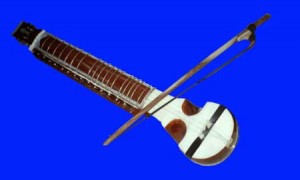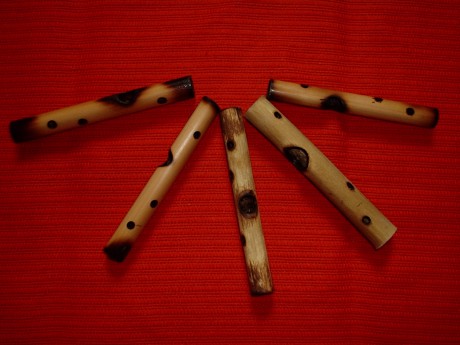Esraj / Esrádž / Dilruba

Esrádž je tradiční indický smyčcový nástroj. Má devatenáct strun, z toho čtyři hlavní a dvě oktávy strun rezonančních, které se ladí do dané stupnice.
Esraj
From Wikipedia, the free encyclopedia
| Classification |
|---|
| Related instruments |
The esraj (also called israj or dilruba) is a string instrument found in two forms throughout the north, central, and east regions of India. It is a young instrument by Indian terms, being only about 200 years old. The dilruba is found in the north, where it is used in religious music and light classical songs in the urban areas. Its name is translated as "robber of the heart." The esraj is found in the east and central areas, particularly Bengal, as well as Bangladesh, and it is used in a somewhat wider variety of musical styles than is the dilruba.
The Dilruba originates from the Taus and was created by the 10th Sikh Guru, Guru Gobind Singh. The instrument was produced to replace the previously heavy instrument (the Taus). This attempt was intended to 'scale down' the Taus into what is now known to be the Dilruba. This made it more convenient for the Sikh army to carry the instrument on horseback.
The structure of both instruments is very similar, each having a medium sized sitar-like neck with 20 heavy metal frets. This neck holds on a long wooden rack of 12-15 sympathetic strings. While the dilruba has more sympathetic strings and a differently shaped body than the esraj, they both have four main strings which are bowed. All strings are metal. The soundboard is a stretched piece of goatskin similar to what is found on a sarangi. Sometimes the instrument has a gourd affixed to the top for balance or for tone enhancement.
The instrument can be rested between the knees while the player kneels, or more commonly rested on the knee of the player while sitting, or also on the floor just in front of the player, with the neck leaning on the left shoulder. It is played with a bow, with the other hand moving along the strings above the frets. The player may slide the note up or down to achieve the portamento, or meend, characteristic of Indian music.
The esraj is mostly used as an accompanying instrument. It is the accompanying instrument of choice for Rabindra Sangeet singing. However, it has also been used as a solo instrument to interpret Hindustani Classical Music, mostly in the Vishnupur tradition. Additionally, the esrag is a more modern invention from the Dilruba that was made and promoted by the Namdharis.
The popularity of the esraj has been steadily declining. Its image as primarily an accompanying instrument has done little to attract new talent.
A R Rahman is known as one of the composers in India who has used the Dilruba, in works like "Dil Se" and "Vande Mataram". Possibly the most famous exponent of the esraj has been Pandit Ranadhir Ray, who died in 1988. Ranadhir Ray was a student of Ashesh Bandopadhyay, and was on the faculty at the Music department of Visva-Bharati University in Santiniketan. Today, the best known exponent is Buddhadeb Das, also from Santiniketa
Categories: Indian musical instruments | String instruments | Bowed instruments | String instruments with sympathetic strings | String instrument stubs
DILRUBA

Dilruba is a cross between the sitar and sarangi. It is extremely close to the esraj and the mayuri vina. It so close that most people are unable to tell them apart. The difference is to be found in the shape of the resonators and the manner in which the sympathetic strings attach. Still they are so similar that a dilruba player has no trouble playing an esraj or a mayuri vina and vice versa.
The construction is very interesting. The neck has approximately 18 strings. The approach to tuning is somewhat similar to the sitar. Like the sitar, almost all of the playing is performed upon only one string. There are a number of metallic frets, some of which will be moved according to the requirements of the rag. It has a series of sympathetic strings which are tuned to the notes of the rag.
The dilruba is popular in north-west India. It is found in Punjab, Uttar Pradesh and Maharashtra.
|
TECHNIQUE - The technique is also a cross between the sarangi and the sitar. It is bowed with a bow (known as gaz) in a manner very much like the sarangi. It is bowed with the right hand while the left hand fingers the strings. There seem to be two schools concerning the fingering of the dilruba. One approach shows a strong influence of the sitar. For this approach, there is a strong preference given to using the index finger. Like the sitar, one occasionally invokes the middle finger to gain speed. This approach seems to be slightly more common in North Eastern India. The other school of seems to show more of an influence from the sarangi. For this approach there is a distinct preference given to the use of the middle finger coupled with the index finger. This approach seems to have the advantage that if one requires speed, on can occasionally use either the index or the ring finger to go in either direction. It is interesting to note though that the proponents of the "sarangi" school of technique seem to be less disposed to invoke such shortcuts to their technique. In either case, one does not solidly lock the string against the fret as one would do with the sitar or most other fretted stringed instruments. One only has to lightly touch the fret against the string. This allows one to alter the intonation with ease. One has no problem raising or lowering the pitch at the fret simply by where on the fret you wish to place the finger. In short, we can think of the frets of the dilruba as being mere guides for correct finger placement. The layout of the strings of the dilruba is very similar to the sitar. This is shown in the illustration to the right. However unlike the sitar, there is no need to move the frets whenever one is playing a note that does not have a fret (e.g., Komal Re or Komal Dha in the middle register.) When one needs to play these notes, one merely has to place the finger in the appropriate point midway between the frets. The meend is also produced in a fashion very differently from the sitar. For the dilruba, one need only slide the fingers up and down along the string in order to produce a meend or any other ornament, where on the sitar one pulls the string laterally across the fret. |
 |

